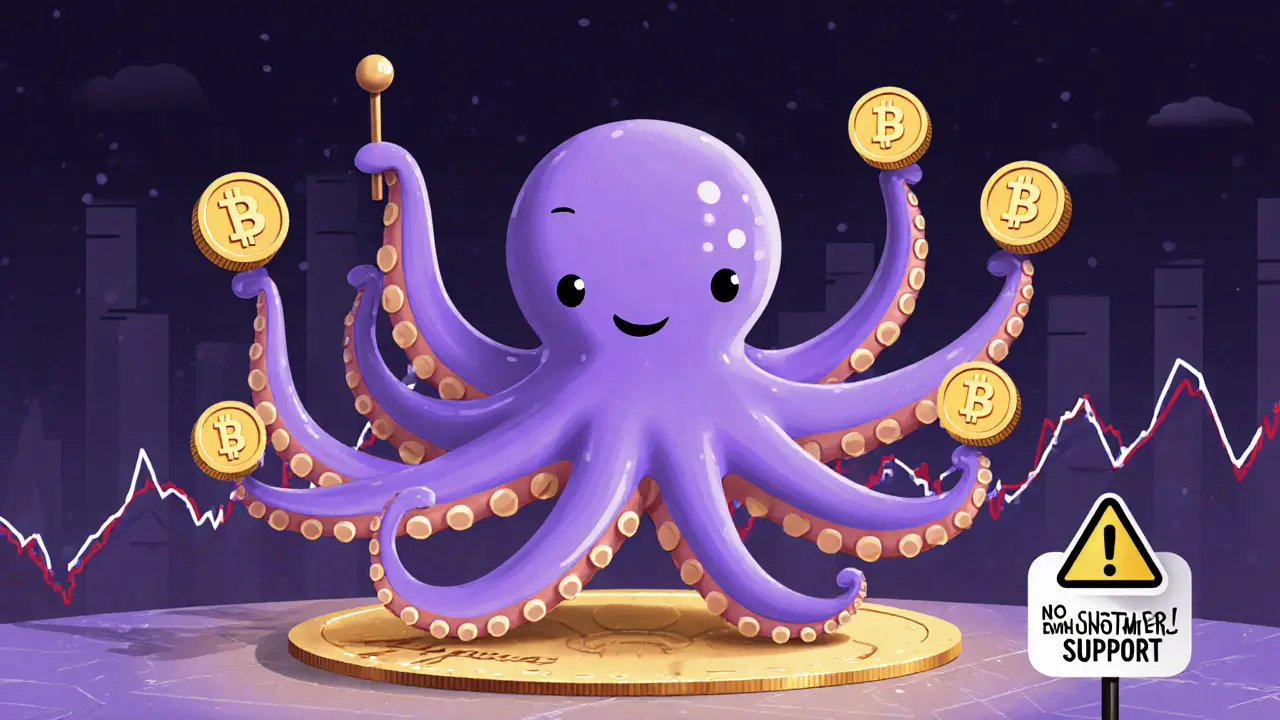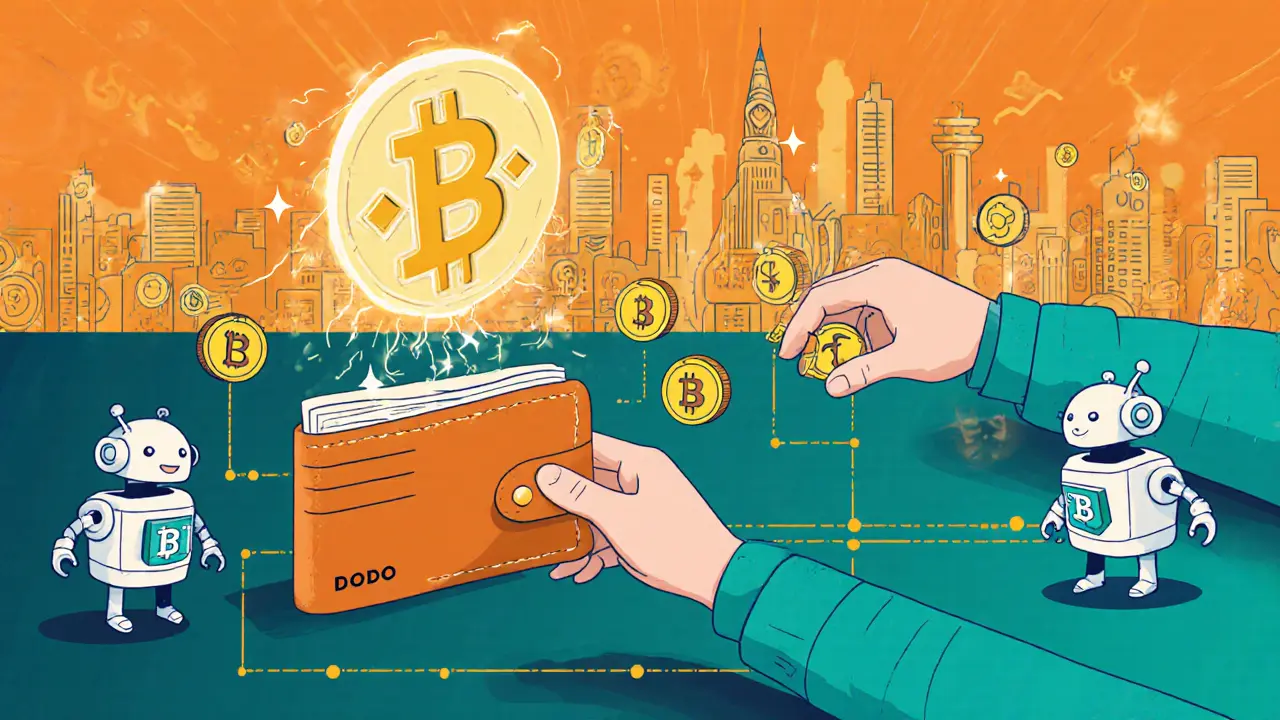Slippage Cost Calculator
Compare Trading Costs
Calculate how much you'd save by trading on DODO versus other DEXs on BSC. Based on 2025 data showing DODO's 0.1-0.3% slippage vs Uniswap's 0.8-1.5%.
Trade Analysis
Based on current 2025 BSC DEX metrics
What Is DODO (BSC) and How Does It Work?
DODO is a decentralized exchange (DEX) built on a blockchain protocol that uses a proprietary Proactive Market Maker (PMM) algorithm to offer tighter spreads and lower slippage than traditional AMMs like Uniswap. Unlike centralized exchanges, DODO doesn’t hold your funds-you connect your wallet and trade directly from it. The BSC version of DODO runs on Binance Smart Chain, which means faster transactions and lower fees than the Ethereum version.
DODO launched in 2020 and quickly stood out because it solved a big problem in DeFi: how to give traders deep liquidity without requiring huge amounts of capital from liquidity providers. Traditional DEXs like Uniswap force you to deposit two tokens in a 50/50 ratio. DODO lets you deposit just one token, which reduces risk and frees up your capital. This is especially useful if you’re providing liquidity for a new token pair that doesn’t have much trading volume yet.
The PMM algorithm is the secret sauce. Instead of relying on a fixed formula to set prices, PMM mimics how human market makers behave-it adjusts prices in real time based on demand. This means if a token starts trending up, DODO raises the price slowly to avoid sudden spikes. The result? Less slippage on big trades and less impermanent loss for liquidity providers.
Why Choose DODO on BSC Over Other DEXs?
If you’re trading on Binance Smart Chain, DODO has real advantages over competitors like PancakeSwap or Uniswap V2. First, fees are low. On BSC, a typical swap costs between $0.10 and $0.50, compared to $5-$50 on Ethereum. That makes it practical for small traders and frequent traders alike.
Second, slippage is noticeably lower. For major token pairs like BUSD/BNB or ETH/USDT, DODO reports slippage between 0.1% and 0.3%. On Uniswap, the same trade might cost you 0.8% to 1.5% in price impact. For a $10,000 trade, that’s $30-$150 saved. That’s not minor-it’s the difference between breaking even and making a profit.
Third, DODO’s SmartTrade feature scans multiple liquidity sources across chains and routes your trade through the best possible path. It’s like using a price comparison tool for crypto, but automated and decentralized. You don’t have to manually check each pool. DODO does it for you.
Compared to PancakeSwap, which dominates BSC with higher volume and more beginner-friendly UI, DODO wins on technical efficiency but loses on ease of use. PancakeSwap has a simpler interface, more tokens listed, and better onboarding. DODO feels more like a tool for people who already know what they’re doing.
Performance Metrics in 2025: Is DODO Still Growing?
DODO’s peak was in early 2021. At that time, its total value locked (TVL) hit over $1 billion, and daily trading volume crossed $66 million. Today, TVL sits at $16.73 million, and 24-hour volume hovers around $6 million. That’s an 89% drop from its high.
On the DEX rankings by TVL, DODO has fallen from #15 in mid-2021 to #28 in 2025. PancakeSwap and Uniswap still hold the top two spots, with TVLs over $2 billion and $1.5 billion respectively. DODO’s market share has shrunk from 3.2% to just 0.7%.
But here’s the catch: DODO’s decline isn’t just about market conditions. It’s also about adoption. While PancakeSwap attracts casual traders with gamified staking and NFTs, DODO’s user base is mostly experienced DeFi users. According to internal data, only 10% of DODO users are beginners. The rest are traders and liquidity providers who care about capital efficiency, not rewards.
The DODO token price tells a similar story. It hit $8.51 in February 2021. By late 2024, it dropped below $0.12. As of November 2025, it’s trading around $1.44. That’s still far from its peak, but it’s recovered from its lowest point. Some analysts predict it could reach $3.50 by end of 2025 if DeFi regains momentum. Others think it could fall to $0.80 if the bear market continues.

Who Should Use DODO (BSC)?
DODO isn’t for everyone. If you’re new to crypto or just want to swap ETH for USDT once a month, use a centralized exchange like Binance or Coinbase. They’re simpler, faster, and regulated.
DODO is for people who:
- Trade large amounts and care about slippage
- Provide liquidity and want to reduce impermanent loss
- Use BSC for low fees and fast confirmations
- Understand wallet security and gas fees
- Don’t mind a slightly complex interface
One Reddit user, u/CryptoLiquidityProvider, reported 40% less impermanent loss on DODO compared to Uniswap V3 when providing ETH/USDC liquidity. That’s a huge win for serious LPs. Another user, u/BSCTrader99, complained about failed transactions during network congestion-even with 15% slippage set. That’s a reminder: DODO’s tech is advanced, but BSC isn’t perfect. Congestion still happens.
If you’re trading altcoins with low liquidity, DODO might not be the best choice. Many token pairs have thin order books, leading to slippage over 5%. Stick to major pairs like BNB, BUSD, USDT, or ETH if you want smooth trades.
How to Use DODO (BSC): A Step-by-Step Guide
Using DODO on BSC isn’t hard if you’ve used MetaMask or Trust Wallet before. Here’s how:
- Install MetaMask or Trust Wallet on your phone or browser.
- Switch your network to Binance Smart Chain. Add the network manually if needed: RPC URL:
https://bsc-dataseed.binance.org, Chain ID: 56. - Buy BNB to pay for gas fees. You’ll need at least $1 worth to cover swaps.
- Go to app.dodoex.io and connect your wallet.
- Click "Swap" and pick your tokens. DODO auto-finds the best route.
- Set slippage tolerance: 0.5% for stablecoins, 1.0-1.5% for volatile tokens.
- Confirm the transaction. Wait 3-10 seconds for confirmation.
For liquidity provision, click "Pool" > "Create Pool" > "Single Token Deposit". Pick your token, enter the amount, and approve. DODO will automatically create a paired liquidity pool with the asset you choose.
Pro tip: Always check the token contract address before approving. Scammers create fake DODO tokens with similar names. Verify on BscScan.

Pros and Cons of DODO (BSC)
| Feature | DODO (BSC) | PancakeSwap (BSC) | Uniswap V3 (Ethereum) |
|---|---|---|---|
| Slippage (avg) | 0.1-0.3% | 0.5-1.0% | 0.8-1.5% |
| Transaction Fee (avg) | $0.10-$0.50 | $0.10-$0.40 | $5-$50 |
| Liquidity Provision | Single-token only | 50/50 pairs only | Custom ranges |
| Beginner-Friendly | Low | High | Medium |
| TVL (Nov 2025) | $16.73M | $2.1B | $1.5B |
| Best For | Advanced traders, LPs seeking efficiency | Beginners, yield farmers | High-volume traders on Ethereum |
What’s Next for DODO? Roadmap and Risks
DODO isn’t standing still. The team has a clear roadmap for 2025-2026:
- Q3 2025: Integration with zkSync and Optimism for Ethereum Layer 2 scaling
- Q1 2026: Launch of DODO v3 with improved cross-chain routing
- Tokenomics overhaul: 20% reduction in circulating supply via buybacks
These updates could revive interest-if they’re executed well. But risks remain. The team is anonymous. There’s no official customer support. If you get stuck, you’re on your own. The main support channel is a Telegram group with 14,300 members. Responses are slow and inconsistent.
Also, DODO isn’t registered with any financial regulator. That means users in the U.S., Canada, and the EU face legal gray areas. You’re trading at your own risk.
Another red flag: active liquidity providers have dropped from over 4,200 in early 2022 to just over 1,000 in early 2025. Fewer providers mean thinner liquidity over time. That’s a slow death spiral if not reversed.
Final Verdict: Is DODO (BSC) Worth It in 2025?
DODO is not a beginner’s DEX. It’s not a place to swap your first ETH for USDT. But if you’re an experienced trader or liquidity provider who wants to minimize slippage and impermanent loss, DODO on BSC is one of the best tools available.
Its PMM algorithm is still unmatched for capital efficiency. No other DEX lets you provide single-token liquidity with such precision. And on BSC, the fees are dirt cheap.
But don’t expect growth. The platform is in maintenance mode. Volume is low. The token is down. Community engagement is fading. DODO survives because of its tech-not its marketing.
If you’re looking for high returns, skip it. If you’re looking for a reliable, efficient tool to execute large trades with minimal price impact, DODO still delivers. Just know what you’re getting into.
Is DODO safe to use on BSC?
DODO’s smart contracts have been audited by reputable firms like CertiK and PeckShield. No major exploits have occurred since launch. However, like all DeFi platforms, you’re responsible for your own security. Always use a trusted wallet, never share your seed phrase, and double-check token addresses before approving transactions. The biggest risk isn’t the code-it’s user error.
Can I stake DODO tokens?
Yes, you can stake DODO tokens to earn rewards. The platform offers staking pools where you lock DODO to receive vDODO, a non-transferable token that gives you voting rights in governance and discounts on trading fees (up to 25%). However, staking rewards have dropped significantly since 2021. Current APYs range from 2% to 8%, depending on pool size and market conditions. Don’t expect high yields like you’d find on centralized platforms.
Why is DODO’s TVL so low compared to Uniswap?
DODO’s TVL is low because it doesn’t rely on yield farming incentives to attract liquidity. Uniswap and PancakeSwap offer massive token rewards to LPs, which floods their pools with capital. DODO’s approach is the opposite: it rewards efficiency, not volume. It attracts professional traders and LPs who care about long-term performance, not short-term airdrops. That’s why its TVL is smaller but more stable.
Does DODO support other blockchains besides BSC?
Yes. DODO operates on Ethereum, Binance Smart Chain, and Polygon. You can swap across these chains using DODO’s cross-chain bridge. However, Ethereum transactions are expensive and slow. BSC is the most practical for daily use. Polygon is good for low-cost, high-volume trades but has less liquidity than BSC.
What’s the minimum amount to start trading on DODO?
There’s no minimum deposit. You can swap as little as $1 worth of BNB or any token. But you need enough BNB to cover gas fees-usually $0.10 to $0.50. For liquidity provision, most users start with $100-$500. Smaller amounts won’t generate meaningful returns due to fees and slippage.
Is DODO better than Uniswap for large trades?
For large trades on BSC, yes. DODO’s PMM algorithm offers significantly lower slippage than Uniswap V2 or V3 on the same chain. For example, a $10,000 trade on DODO might have 0.8% slippage, while the same trade on Uniswap could be 3.2%. That’s a $240 difference. On Ethereum, Uniswap V3’s concentrated liquidity can compete, but DODO’s single-token deposit feature still gives it an edge for LPs.

Mike Calwell
November 15, 2025 AT 15:34